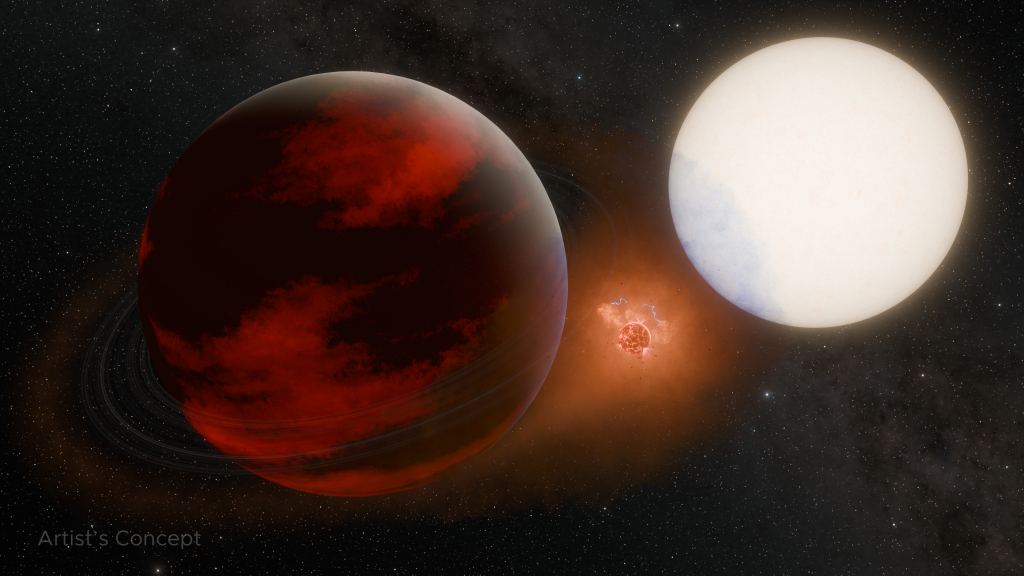In 2012, astronomers detected a gas giant transiting in front of WASP-49A, a G-type star located about 635 light-years from Earth. The data obtained by the WASP survey indicated that this exoplanet (WASP-49 b) is a gas giant roughly the same size as Jupiter and 37% as massive. In 2017, WASP-49 b was found to have an extensive cloud of sodium, which was confounding to scientists. Further observations in 2019 using the *Hubble Space Telescope* detected the presence of other minerals, including magnesium and iron, which appeared to be magnetically bound to the gas giant.
WASP-49 b and its star are predominantly composed of hydrogen and helium, with only trace amounts of sodium - not enough to account for this cloud. In addition, there was no indication of how this sodium cloud was ejected into space. In our Solar System, gas emissions from Jupiter's volcanic moon Io create a similar phenomenon. In a recent study, an international team led by scientists from NASA's Jet Propulsion Laboratory found potential evidence of a rocky, volcanic moon orbiting WASP-49 b. While not yet confirmed, the presence of a volcanic exomoon around this gas giant could explain the presence of this sodium cloud.
The study was led by Apurva Oza, a former postdoctoral researcher at NASA's Jet Propulsion Laboratory and now a staff scientist at Caltech. He was joined by colleagues from NASA JPL and researchers from the European Southern Observatory (ESO), the Indian Institute of Astrophysics, the Caltech/IPAC-NASA Exoplanet Science Institute, the Institute of Science and Technology Austria (ISTA), the Birla Institute of Technology and Science, and multiple universities. The paper that details their findings was recently published in *The Astrophysical Letters*.
Io is the most volcanic body in our Solar System, with hundreds of active volcanoes and extensive lava formations. This activity is the result of tidal interaction with Jupiter's powerful gravitational field, which causes the interior of Io to flex and contract, creating dense lava flows that break through the surface. These volcanoes spew lava up to 300 km (186 mi) into space, along with sulfur dioxide, sodium, potassium, and other gases, creating a massive cloud around Jupiter up to 1,000 times the planet's radius.
While the team's observations did not detect any exomoons directly around WASP-49 b, a massive sodium cloud could constitute indirect evidence of a volcanic moon that is simply too small and dim to detect. For years, Oza has investigated how exomoons might be detected via their volcanic activity. To determine if this was the case around WASP-49 b, he and the team observed WASP-49 b over time using the Echelle SPectrograph for Rocky Exoplanets and Stable Spectroscopic Observations (ESPRESSO) on the ESO's Very Large Telescope (VLT).
This proved quite challenging because of the distance involved and the way the star, planet, and cloud often overlap, making it very difficult to distinguish between them. Nevertheless, their observations revealed several pieces of evidence that suggest that a separate body is responsible for the sodium cloud. For example, their observations indicated that the cloud suddenly increased in size during two observations, suggesting it was being replenished. In fact, they estimate that the cloud is replenished at a rate of 100,000 kg (220,000 lbs) per second.
They also observed the cloud moving faster than the planet, suggesting it was generated by another body orbiting faster than the planet. "We think this is a really critical piece of evidence," said Oza. "The cloud is moving in the opposite direction that physics tells us it should be going if it were part of the planet's atmosphere." Their observations also noted something interesting as WASP-49 b orbited its parent star every 2.8 days. During this time, the cloud appeared and disappeared behind the star or the planet irregularly.
To address this, the team also used a computer model to simulate the presence of an exomoon and compare it to their observations. Their results showed that an exomoon with an orbital period of eight hours could explain the cloud's motion and activity, including how it appeared to pass in front of the planet and will disappear and reappear at intervals. Another takeaway from this study was what it suggests about this possible exomoon's future.
If WASP-49 b is similar in size to Earth's Moon, Oza and his colleagues estimate that the tidal interaction with the planet's gravity and its rapid mass loss will eventually cause it to disintegrate. "If there really is a moon there, it will have a very destructive ending," said Oza. While these observations are intriguing, the team emphasizes that follow-up observations are needed to learn more about the cloud's orbit and structure.
Further Reading: NASA*, The Astrophysical Letters*
 Universe Today
Universe Today

